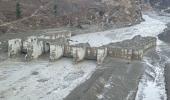Using drones and remote-sensing equipment, rescue teams intensified efforts on Wednesday to reach the 25-35 men trapped in a sludge-choked tunnel since the Uttarakhand glacier disaster three days ago and more than 170 remained missing, hopes of finding them alive fading with every passing hour.

The multi-agency rescue operation at the National Thermal Power Corporation (NTPC) hydel project site has been going on uninterrupted since Sunday, when a possible glacier break in the upper reaches of the Himalayas triggered an avalanche and floods in the Alaknanda river system, with no breakthrough in sight, officials said.
So far, 32 bodies have been recovered from different places in the disaster-hit areas of Chamoli district.
Eight bodies have been identified and 174 people are still missing, the State Emergency Control Centre in Dehradun said.
The missing people include those working at NTPC's 480 MW Tapovan-Vishnugad project and the 13.2 MW Rishiganga Hydel Project and villagers whose homes were washed away as a wall of water came hurtling down mountainsides.
A focal point of the rescue work has been efforts to penetrate through tonnes of silt, sludge and debris to get to the 25-35 people, who were at work inside the 1,500 metre tunnel at Tapovan when the waters came rushing in.
"All strategies at the moment are focussed on rescuing those trapped inside the tunnel with the help of all the resources at our disposal, including drones and remote-sensing equipment," Deputy Inspector General (DIG) Nilesh Anand Bharne, Uttarakhand Police chief spokesperson, told PTI at Tapovan.
Drilling through the debris has become more difficult with the silt inside the tunnel drying up and getting harder, he said.
Rescue teams have so far managed to progress 80 metres inside the tunnel and have to make their way through tonnes of debris for at least 100 metres more to reach those trapped inside, the DIG added.
The complicated design of the tunnel is making the task even more difficult, prompting the rescue teams to consult NTPC officials.
More than 600 Army, Indo-Tibetan Border Police (ITBP), National Disaster Response Force (NDRF), State Disaster Response Force (SDRF) and Sashastra Seema Bal (SSB) personnel are engaged in the search-and-rescue operations.
Several measures, including drilling holes to take oxygen to the men inside the tunnel, are also being contemplated, added project consultant A K Shrivastava.
The multi-agency group of rescuers flew a camera-equipped drone inside the Tapovan tunnel on Tuesday but could not pinpoint the location of survivors or the way forward due to darkness, a senior NDRF officer said.
"We are still hopeful. The teams will continue making attempts, clearing the slush to enter deeper into the tunnel and locate the trapped," he said.
As rescuers said they were 'hoping against hope' to reach the workers at the soonest, outside the tunnel, family members of those inside waited with bated breath to hear news about their loved ones.
Officials on the ground and those monitoring the rescue from Delhi told PTI the continuous accumulation of slush and silt inside the tunnel is the biggest hurdle for rescuers.
"Heavy machines have removed more slush from the tunnel the whole night. A joint team of ITBP, NDRF, SDRF and sister agencies entered the tunnel this morning... more slush and water coming from inside the tunnel is making the way ahead difficult," ITBP spokesperson Vivek Kumar Pandey said in the national capital.
The ITBP has deployed a team of about 450 personnel apart from those from the NDRF, state disaster response force and the Army.
When contacted, Uttarakhand Director General of Police Ashok Kumar said all possible efforts will be made to save the lives of those trapped inside the tunnel.
The villages that lost road connectivity in the wake of the calamity are Raini Palli, Pang, Lata, Suraithota, Suki, Bhalgaon, Tolma, Fagrasu, Long Segdi, Gahar, Bhangyul, Juwagwad and Jugju.
Relief is being distributed by helicopters among villagers cut off due to the washing away of a bridge in the avalanche at Malari.
The total population of these villages is around 2,500, officials said on Tuesday.
On Tuesday, Uttarakhand Chief Minister Trivendra Singh Rawat undertook an aerial survey of the affected areas, visited the ITBP hospital in Joshimath, about 295 km from Dehradun, and met the 12 workers who were rescued from a small tunnel in Tapovan on Sunday evening.
"The event happened in a hanging glacier, adjacent to Raunthi glacier, which originates from Raunthi/Mrigudhani peak (6,063 metres above sea level)," Kalachand Sain, director of the Wadia Institute of Himalayan Geology, said.
A hanging glacier is a body of ice that breaks off abruptly at the edge of a precipice or steep slope.
The observations also suggest that rock mass weakened over a period of time due to freezing and thawing of snow. This must have led to the creation of a 'weak zone', triggering its collapse, which resulted in the formation of a temporary dam that eventually breached, causing the floods.










